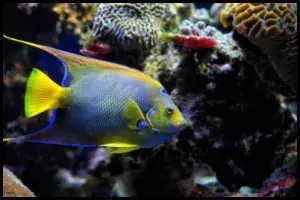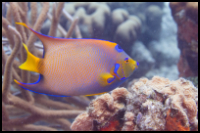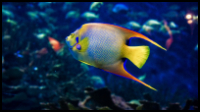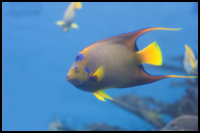





Quick Care Details (Table)
| Livestock Characteristics | Value |
|---|---|
| Care Level | Moderate |
| Temperament | Semi-Aggressive |
| Diet | Omnivore |
| Maximum Size | 1ft & 6 Inches |
| Minimum Tank Size | 250 Gallons |
| Reef Compatible | With Caution |
| Temperature Range | 72-78F |
| PH Range | 8.1-8.4 |
| DKH Range | 8-12 |
| Salinity Range | 1.020-1.025 |
Species Specific Categories
Helpful Video
Care Details
Aquascape:
- Provide ample hiding spots with live rock formations resembling natural reef structures.
- Incorporate caves, crevices, and coral formations to mimic the Queen Angelfish's natural habitat.
Substrate:
- Use a fine to medium-grain sand substrate, resembling the sandy areas found in reef environments.
Disease Prevention:
- Quarantine new arrivals to prevent the introduction of diseases to the main tank.
- Maintain a clean and stable environment to minimize stress and susceptibility to diseases.
Filtration:
- Utilize a high-quality protein skimmer to help maintain water quality by removing organic matter.
- Implement mechanical and biological filtration systems to ensure optimal water conditions.
Lighting:
- Provide moderate to high-intensity lighting to support the growth of algae and microorganisms, which are part of the Queen Angelfish's diet.
- Use a spectrum that mimics natural sunlight to enhance the fish's colors.
Water Flow:
- Create gentle to moderate water flow patterns to simulate the natural currents of reef environments.
- Avoid excessive turbulence that might stress the fish.
Hardiness:
- Queen Angelfish can be moderately challenging to care for due to their specific dietary needs and territorial behaviors.
- They require a well-maintained environment with stable water parameters.
Acclimation:
- Acclimate new arrivals gradually by slowly adjusting water parameters over several hours.
- Use a drip acclimation method to prevent shock and stress.
Special Requirements:
- Offer a varied diet that includes marine-based foods, algae, sponges, and small invertebrates.
- Be prepared for potential aggression as the fish matures; provide ample space and hiding spots.
- Select tank mates carefully, avoiding other angelfish or similarly colored species.
- Support responsible aquaculture and captive breeding efforts to reduce pressure on wild populations.
Temperament and Behavior
Behavior and Social Interaction:
- Queen Angelfish are generally solitary creatures, often encountered alone or in pairs.
- They can exhibit curious and exploratory behaviors, investigating their surroundings.
- Their interactions can include territorial displays and occasional aggression, especially with similar-looking species.
Aggression:
- As they mature, Queen Angelfish can become territorial and aggressive toward other angelfish or similar species.
- It's recommended to house them alone or with peaceful tank mates to minimize potential conflicts.
Breeding:
- Breeding Queen Angelfish in captivity is challenging due to their complex reproductive behaviors and specific requirements.
- They engage in external fertilization, where eggs and sperm are released into the water column during courtship.
Compatibility:
- Choose tank mates that are peaceful, not prone to aggression, and not similar in appearance to the Queen Angelfish.
- Avoid housing them with other angelfish or species that might trigger territorial conflicts.
Activity Level:
- Queen Angelfish have a moderate to high activity level, often exploring the nooks and crannies of their environment.
- They spend time foraging for food and inspecting their territory.
Clean-Up Crew:
- While Queen Angelfish may nibble on algae, they are not highly effective as a primary "clean-up crew" for algae control.
- Supplement their diet with other marine-based foods to meet their nutritional needs.
Schooling or Shoaling Behavior:
- Queen Angelfish do not typically exhibit schooling or shoaling behavior.
- They are more solitary in nature, except during courtship and potential pair formations.
Coral Reef Compatability :
- These fish need caution when introduced to a coral reef aquarium
- They will commonly nip at soft corals but have a good chance to leave your SPS coral alone.
- These marine angelfish will generally leave your shrimp alone unless the shrimp is extra small.
- They will leave most snails alone unless they have been stuck on their back for a long period of time.
- Hermits crabs and other crustaceans are generally safe as they have safe places to hide.
Diet and Nutrition
Dry Foods:
- Offer high-quality, marine-based pellets and flakes designed for angelfish.
- Choose formulas rich in protein and fortified with vitamins and minerals.
Frozen Foods:
- Provide a variety of frozen foods like mysis shrimp, brine shrimp, and chopped seafood.
- Thaw and rinse frozen foods before feeding to ensure optimal nutritional value.
Live Foods:
- This fish can accept live foods such as small crustaceans, copepods, and amphipods.
- Live foods can enhance their natural foraging behaviors.
Vegetables:
- Offer occasional vegetable matter like blanched spinach, seaweed sheets, and spirulina-based foods.
- Vegetables can provide essential fiber and nutrients to their diet.
Algae:
- Queen Angelfish graze on filamentous algae and sponge material in their natural habitat.
- While they may consume some algae in captivity, it's best to supplement their diet with other foods.
Feeding Schedule:
- Feed small portions multiple times a day to mimic their natural grazing behavior.
- Aim for 2 to 3 feedings daily, adjusting quantities based on their consumption rate.
Supplemental Foods:
- Introduce high-quality angelfish-specific vitamin supplements to ensure they receive essential nutrients.
- These supplements can enhance their overall health and coloration.
Tank Parameters
Tank Size:
- Provide a spacious aquarium of at least 180 gallons to accommodate their size and active nature.
- Larger tanks help reduce stress and territorial aggression.
Tank Length and Measurements:
- Aim for a tank that is at least 6 feet (1.8 meters) in length to allow ample swimming space.
- A depth of around 2 feet (60 cm) provides room for natural behaviors.
Species Maximum Size:
- Holacanthus ciliaris can reach lengths of up to 18 inches (45 cm) in the wild.
- While their size might be slightly smaller in captivity, plan for a tank that can accommodate their potential growth.
Water Temperature:
- Maintain water temperature between 72 to 78°F (22 to 26°C) for the comfort of this fish.
- Consistent temperatures are crucial to preventing stress and health issues.
pH (Acidity/Alkalinity):
- Maintain pH levels within the range of 8.1 to 8.4.
- Stability in pH helps maintain the overall health of the fish.
Nitrate (NO3) Levels:
- Keep nitrate levels at or below 20 ppm to prevent water quality issues.
- Regular water changes and proper filtration help control nitrate levels.
Salinity:
- Maintain a specific gravity of 1.020 to 1.025, corresponding to a salinity level of 30 to 35 ppt (parts per thousand).
- Consistent salinity is crucial for osmoregulation and overall health.
Phosphate (PO4):
- Aim to keep phosphate levels low, ideally below 0.03 ppm.
- Controlling phosphate helps prevent algae growth and maintains water quality.
Alkalinity (dKH):
- Maintain alkalinity levels in the range of 8 to 12 dKH (degrees of carbonate hardness).
- Stable alkalinity supports proper calcium metabolism and coral health in reef environments.
History, Popularity, History and Species Variety Details
The History, Popularity, and Habitat of The Queen Angelfish
History:
The Queen Angelfish, scientifically known as Holacanthus ciliaris, is a splendid marine species that has captured the attention of divers, aquarists, and enthusiasts around the world. With its striking colors, intricate patterns, and captivating behavior, this fish has become a symbol of the vibrant ecosystems found in the tropical waters of the western Atlantic Ocean.
Popularity:
The Holacanthus ciliaris has earned its place in the hearts of marine enthusiasts due to its breathtaking appearance. Its vivid blue, yellow, and orange hues blend together in a harmonious display that rivals the beauty of coral reefs themselves. As one of the larger angelfish species, its imposing presence adds a touch of grandeur to both natural habitats and well-maintained aquariums. Its popularity in the aquarium trade is a testament to its allure, though responsible practices, such as aquaculture and captive breeding, are increasingly emphasized to reduce pressure on wild populations.
Habitat:
This regal angelfish inhabits the warm, tropical waters of the western Atlantic Ocean. From the coast of Florida to the Caribbean Sea and as far south as Brazil, the Queen Angelfish finds its home amidst the intricate tapestries of coral reefs. These vibrant ecosystems provide the perfect backdrop for the fish's vibrant colors and active behaviors.
Within these reefs, the Holacanthus ciliaris navigates a complex world of corals, sponges, and various marine life. It gracefully maneuvers through crevices and coral formations, exploiting its agility to forage for food and explore its territory. As a territorial species, it stakes its claim on sections of the reef, where it actively feeds on algae, sponges, and invertebrates.
Ecological Importance:
Beyond its visual splendor, the Holacanthus ciliaris plays a vital role in maintaining the health of coral reef ecosystems. Its grazing habits help control algae growth, preventing overgrowth that could suffocate corals and other marine life. By contributing to the delicate balance of reef environments, the Queen Angelfish showcases its ecological significance beyond its aesthetic appeal.
Conservation Efforts:
Due to its popularity and the potential threats to its wild populations, the Queen Angelfish serves as a reminder of the importance of responsible conservation practices. Overfishing and habitat degradation can impact its natural habitats, making efforts such as marine protected areas and sustainable fishing practices crucial for preserving this species and its home reefs.
Similar Marine Fish Species to The Queen Angelfish
Blue Angelfish (Holacanthus bermudensis):
This species closely resembles the Queen Angelfish in appearance, with a similar blue and yellow coloration.
It is found in the western Atlantic, primarily in the Bermuda region.
Blueface Angelfish (Holacanthus tricolor):
The Blueface Angelfish features a striking blue face with a contrasting yellow body.
It is found in the Indo-Pacific region and is not to be confused with the Atlantic Queen Angelfish.
Common Tank mates for The Queen Angelfish
Tangs (Surgeonfish):
Some tang species, like the Yellow Tang and Hippo Tang, can be compatible due to their peaceful nature and distinct swimming patterns.
Butterflyfish:
Many butterflyfish species are peaceful and can coexist with the Angelfish, such as the Raccoon Butterflyfish or the Longnose Butterflyfish.
Wrasse:
Peaceful wrasse species, like the Six-Line Wrasse or the Melanurus Wrasse, can make good tank mates.
Clownfish:
Clownfish are generally compatible due to their peaceful demeanor and their preference for different areas within the tank.
Anthias:
Some anthias species, like the Lyretail Anthias, can coexist well due to their peaceful schooling behavior.
Certain Angelfish Species:
While it's generally advisable to avoid housing multiple angelfish species together, some peaceful dwarf angelfish, like the Coral Beauty Angelfish, can sometimes coexist with the Queen Angelfish.
Frequently Asked Questions
Can Queen Angelfish be kept with other angelfish species?
It's generally advisable to avoid housing multiple angelfish species together, as they can become territorial and aggressive towards each other. Exceptions include peaceful dwarf angelfish.
What is the natural habitat of the Queen Angelfish?
The Queen Angelfish is found in the warm, tropical waters of the western Atlantic Ocean and the Caribbean Sea, specifically among coral reefs.
What is the lifespan of a Queen Angelfish in captivity?
With proper care, Queen Angelfish can live up to 10 to 15 years or more in captivity, depending on factors such as water quality, diet, and environment.
Are Queen Angelfish prone to any specific diseases?
Like all marine fish, Queen Angelfish are susceptible to common aquarium fish diseases such as ich. Quarantine new arrivals and maintain optimal water conditions to minimize health issues.
How can I prevent or minimize the aggressive behavior of my Holacanthus Ciliaris?
Providing ample space, appropriate hiding spots, and choosing peaceful tank mates can help reduce the territorial and aggressive tendencies of Queen Angelfish.
Are Holacanthus Ciliaris suitable for reef aquariums with corals?
Queen Angelfish can sometimes nip at corals and sessile invertebrates in reef aquariums, making them better suited for fish-only or carefully selected mixed reef setups.

